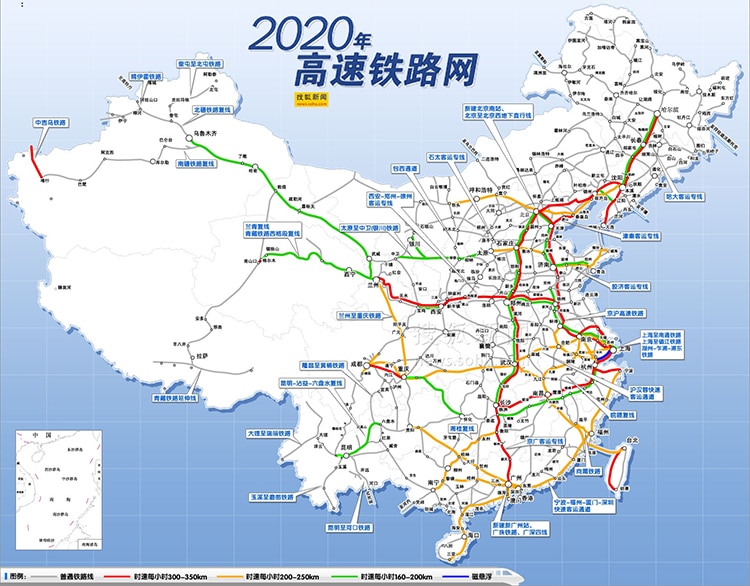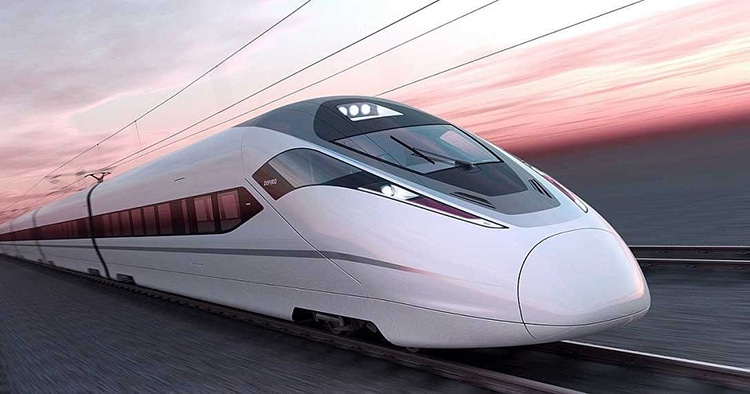The Beijing-Shanghai High-speed Railway, also known as the Beijing-Shanghai Passenger Dedicated Line, is a high-speed railway connecting Beijing and Shanghai. The Beijing-Shanghai high-speed railway officially started on April 18, 2008; on June 30, 2011, the entire line was officially opened to traffic. The Beijing-Shanghai high-speed railway runs from Beijing South Station to Shanghai Hongqiao Station, with a total length of 1,318 kilometers and 24 stations. The designed maximum speed is 380 kilometers per hour. As of September 2017, the Beijing-Shanghai high-speed railway operates at a speed of 350 km / h. As of January 16, 2020, the Beijing-Shanghai high-speed railway has been in operation for the 8th anniversary, and sent 1.1 billion passengers. On January 16, 2020, Beijing-Shanghai High-speed Railway Co., Ltd. was listed on the main board of the Shanghai Stock Exchange, becoming China’s most profitable high-speed rail.
China’s high-speed rail lines add 5,000 kilometers a year

According to statistics, domestic high-speed rail operating mileage exceeds 35,000 kilometers, accounting for about 70% of the world. At the same time, China is also the first country in the world to operate a high-speed rail network. Some figures show that in 2019 alone, the domestic new high-speed rail mileage exceeded 5,000 kilometers, which is an amazing figure. Up to now, except for a few provinces and cities such as Tibet and Macau, the high-speed rail network has been connected in China.
Today’s high-speed rail economy has become an important part of economic and social development. For example, the completion of the high-speed rail network has greatly enhanced the efficiency of the retail industry. Today, many domestic express delivery companies have begun to adopt the mode of express delivery of high-speed rail. This not only improves transportation efficiency, but also saves transportation costs. However, it is very difficult for China’s high-speed rail to have the scale as it is today.
Development of China’s High-speed Rail Enterprise
In the late 1990s, trains running at a speed of 65 kilometers per hour were still running on China’s main railway network, and this was still in the context of the speed increase in the 1980s. Even so, the speed of China’s railways at that time was far less than that of Japan’s Shinkansen. According to the data, the latter was at a speed of 200 km / h, which is quite different. Although domestic railways have experienced several speed increases since then, they still cannot meet demand.
At this time, the high-speed rail naturally entered people’s vision. In 2004, China announced that it would tender 200 km / h EMUs worldwide. For many international companies, this is an opportunity, including companies from Germany, France, Japan and other countries to participate. After arduous negotiations, a plan for technology introduction, digestion, and innovation was finally determined. Four years later, the first domestic high-speed railway was officially opened. This is the Beijing-Tianjin railway, and China officially entered the era of high-speed railway.
China’s high-speed rail increased by 22,000 kilometers in 8 years
In the decades that followed, the Chinese let the world see what China’s speed is, and China’s high-speed rail industry has entered an era of rapid development. In 201, as China fully mastered the operation control system technology on high-speed rail, it also meant that the high-speed rail had achieved 100% localization. In addition, China’s high-speed rail mileage is also increasing rapidly, from 13,000 kilometers in 2011 to 35,000 kilometers at the end of last year.
Beijing-Shanghai high-speed rail line trend

The Beijing-Shanghai high-speed railway passes through North China and East China, and connects Beijing-Tianjin-Hebei and the Yangtze River Delta economic regions at both ends. The plains are the main part along the line, and the low-lying hilly areas are part of the route. The area of the river system is one of China’s areas with active socio-economic development, and it is also a passenger-only line with relatively busy passenger and cargo transportation and great growth potential.
The Beijing-Shanghai high-speed railway is roughly parallel to the existing Beijing-Shanghai railway, with a main line of 1,318 kilometers in length, which is about 145 km shorter than the existing Beijing-Shanghai line. It leads from the west end of Beijing South Railway Station, along the existing Beijing-Shanghai Railway, and through Tianjin ’s new Tianjin South The station is connected to the Tianjin West Railway Station by the construction of a liaison line; southward along the Beijing-Shanghai Expressway, across the Yellow River 3 kilometers downstream of the Yellow River Bridge on the Beijing-Shanghai Expressway, a new Jinan West Passenger Station is set up on the west side of Jinan City; south along Jingfu On the east side of the expressway, southbound, a new Xuzhou East Station is set up in the east of Xuzhou City; Bengbu South Station is set across the Huaihe River at 1.2km downstream of the Xinhuaihe Railway Bridge in Bengbu, crossing the Luan River, and 20 kilometers upstream of the existing Nanjing Yangtze River Bridge. The Shengguan Yangtze River Bridge crossed the river into the newly-built Nanjing South Railway Station and finally reached Shanghai Hongqiao Railway Station. Tianjin, Jinan, Xuzhou, Bengbu, Nanjing, Shanghai and other hub areas are introduced into existing stations through the construction of liaison lines.
Beijing-Shanghai High Speed Rail Operation
In the initial stage of the Beijing-Shanghai high-speed rail, 90 pairs of action cars will be opened every day, and two modes of mixed speeds of 300 kilometers per hour and 250 kilometers per hour will be implemented.
On December 6, 2010, the Beijing-Shanghai high-speed rail main model CRH380A EMU physical model was unveiled. Beijing-Shanghai high-speed rail trains will be implemented in 8/16 cars, with a capacity of 1,004.
On January 9, 2011, during the Beijing-Shanghai high-speed railway pilot section operation test, the new generation CRH380BL high-speed EMU, independently developed and developed by the former China North Locomotive Group Tangshan Rail Passenger Car Co., Ltd., created 487.3 kilometers per hour The highest speed of the world railway operation test; On the morning of June 13, the Ministry of Railways of the People’s Republic of China held a press conference to announce the Beijing-Shanghai high-speed rail fares, operating maps, opening dates and other information; Shanghai high-speed railway begins to sell tickets online. Passengers can purchase electronic tickets through China Railway Customer Service Center 12306.
On April 13, 2012, high-tech security systems for face recognition-face recognition systems-will be installed in the security inspection areas of Shanghai Hongqiao Station, Tianjin West Station, and Jinan West Station. From July 1, High-speed rail will increase capacity. The former Beijing Railway Administration increased from 65 pairs of Beijing-Shanghai high-speed rail to 67 pairs daily, 72 pairs to 74 pairs on weekends, and 78 pairs to 79 pairs during peak periods.
On June 26, 2017, the Chinese standard EMU “Fuxing” made two-way debuts at Beijing South Station and Shanghai Hongqiao Station at both ends of the Beijing-Shanghai high-speed rail; on September 21 of the same year, the Beijing-Shanghai high-speed train operated at a speed of 350 km / h.
Significance of Beijing-Shanghai High Speed Rail Value
Since the Beijing-Shanghai high-speed railway started operation, its infrastructure has been in good condition, its traffic has grown rapidly, and its operations are safe and orderly. By the end of 2015, it had transported more than 400 million passengers. The goal has achieved good economic and social benefits. The Beijing-Shanghai high-speed railway has established China’s high-speed railway standard system and technical system, which supports the rapid development of China’s high-speed railway, and has created a Chinese high-speed railway brand with advanced technology, safety, reliability and high cost performance. The high-speed railway represented by the Beijing-Shanghai high-speed railway has become a bright business card in China.
The construction and operation of the Beijing-Shanghai high-speed railway is of great significance to China’s economic and social development; through technological innovation and standardized management, engineering technology, quality and management have reached world advanced levels.
The Beijing-Shanghai high-speed railway will be the world’s first high-speed railway with the longest lines and the highest standards. It will also be the largest investment project in China since the founding of the PRC.